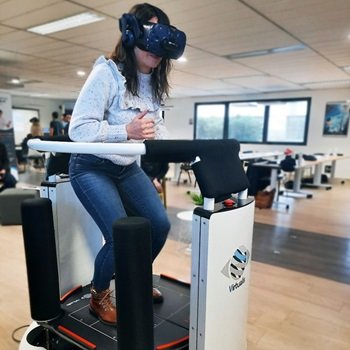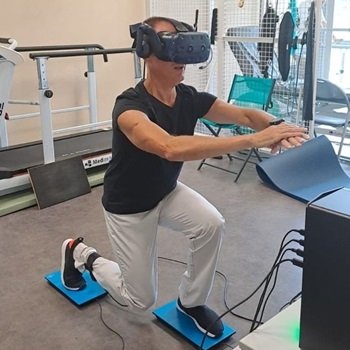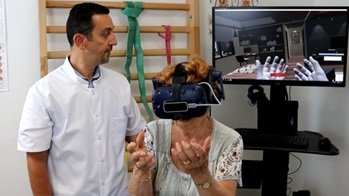Virtual Reality (VR) is an innovative tool that puts people into lifelike computer-generated environments. This technology delivers visual information that transforms physical therapy sessions into engaging and motivating patient experiences.
This blog summarizes key research supporting the use of VR therapy for common conditions treated by physical therapists.
Why use VR for Physical Therapy
- Research supports virtual reality-based therapy for diagnostics and rehabilitation in physical therapy.
- VR therapy is immersive, engaging, and improves patient motivation and adherence to treatment plans.
"First, a smile in the first few seconds. Then the amazement at the pleasant immersion in VR. In the end, the majority say: "It's really good," "it's fun," and "you feel like you're working." It's the therapeutic tool that reinvigorates patient care and enables them to work in a global or targeted way."
Carine Debrune, Physiotherapist
- Therapists can customize VR programs to individual needs and progression.
- Real-time monitoring allows therapists to adjust interventions as needed.
- Systems such as Virtualis provide objective data, offering valuable insights for therapists. This data allows tracking improvements over time and customizing treatment plans with real-time, data-driven feedback.

Learn More
What is Virtual Reality Rehabilitation?
Virtual reality rehabilitation is a therapeutic approach that utilizes VR technology to enhance the rehabilitation process for individuals with various physical or cognitive conditions. In this context, individuals wear VR headsets or use other VR devices to immerse themselves in simulated environments. These environments are designed to facilitate specific exercises, activities, or scenarios that target the rehabilitation goals of the individual.
VR in Physical Therapy: The Research
VR and Hemiplegic Treatment
In a recent study, ten stable hemiplegic patients participated in VR therapy sessions three times a week. All exhibited promising outcomes, including decreased spasticity, enhanced functional abilities, and a clear tendency to reintegrate the affected limb into daily activities. Researchers highlighted the potential of immersive VR therapy, suggesting further exploration, particularly for patients at various stages of cerebral palsy.
Gait and Postural Balance with VR
Virtual reality studies reveal gait differences in Parkinson's disease (PD) patients, showing response patterns to stimuli. VR also effectively detects balance deficits in subacute mTBI patients, aiding rehabilitation.
In a 12-week study with 28 PD patients, those receiving VR training demonstrated superior balance and gait improvements, especially in the Unified Parkinson's Disease Rating Scale (UPDRS3), compared to conventional therapy.

Fall Prevention Physical Therapy and VR
In a meta-analysis of 28 studies with 1121 elderly participants, VR games positively impacted balance and fear of falling compared to no intervention and outperformed conventional interventions.
A meta-analysis of six studies showed significant improvements in mobility and balance with virtual reality games after 3–6 and 8–12 weeks of intervention compared to no intervention.

Stroke Rehabilitation and VR
In stroke rehabilitation, integrating VR enhances patient enjoyment and reduces perceived difficulty. Studies exploring patient experiences during VR activities highlight factors like ease of following directions, pain, achieved scores, novelty, and feedback.
Additionally, augmented reality-based postural control training shows promise in improving poststroke gait function. In a pilot study on chronic stroke patients, a virtual walking program using real-world video recordings significantly improved walking balance and spatiotemporal gait parameters, including velocity and cadence, compared to standard treadmill training. These findings suggest the potential value of the virtual walking program in enhancing gait performance for chronic stroke patients.
Using VR to Treat Pain from Burns or Phantom Limb
Studies on VR therapy for pain in burn patients and amputees with phantom limb pain show positive outcomes. VR therapy is well-received by both children and adults with burn injuries, resulting in high cooperation, low pain scores, and discomfort levels.
Combining VR with traditional therapy for burned hands improves hand function, while VR also significantly reduces pain and discomfort in amputees with phantom limb pain.
“The results were really excellent, since it only took 10 sessions of rehabilitation, and we achieved a result where there was no longer any need to take medication and perfect pain relief. And [the patient] feels better with her finger. The results in terms of pain were really excellent and in 10 sessions, it’s remarkable.”
- Stéphane Fabri, Physiotherapist

VR-based therapy is proven and effective, benefiting patients with various conditions. Integrating VR into your toolkit enhances outcomes, boosts patient engagement, and provides a dynamic, evidence-backed solution for physical therapy.
Virtualis
Virtualis is a functional rehabilitation VR system designed by a physical therapist and a dedicated research team. Widely utilized in 450 facilities worldwide, Virtualis VR focuses on activities of daily living, balance, motor function, cognition, proprioception, and mirror therapy. Physical therapists prefer Virtualis for its user-friendly interface and healthcare-specific design.
Virtualis Solutions
PhysioVR - Provides diverse modules for assessments and rehabilitation, catering to orthopedic concerns, sports medicine, concussion, chronic pain, cognitive improvement, neurological, and balance training.
*Add MotionVR or StaticVR for unified functional rehab in orthopedics, lower extremities, proprioception, and sports medicine.
StaticVR - Integrated VR on static force plates for assessments and rehabilitation.
MotionVR - 360° moving dynamic force plate with integrated VR.
Interested in incorporating virtual reality into your physical therapy practice? Contact your nearby e3 Diagnostics location for expert guidance today.
Contact Us
Other Good Reads: Virtual Reality Physical Therapy Benefits with Virtualis
Sources
Use of Virtual Reality in Physical Therapy as an Intervention and Diagnostic Tool
Virtual Reality Interest in Chronic Vascular Hemiplegia
Follow us on Social!



If you haven't already, make sure to subscribe to our newsletter to keep up-to-date with our latest resources and product information.